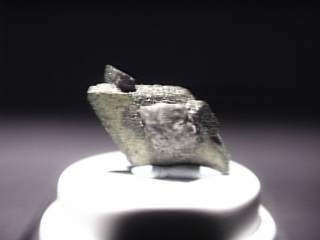
SPHENE
Specimen spe-4
$ 21.00
Dims: 0.8" x 0.5" x 0.3"(2.0 x 1.3 x 0.8 cm)
Wt: 1.1 g
Thormale, Nala, Pakistan
This excellent little thumbnail specimen consists of three intergrown, diamond-shaped, crystals of Sphene. The largest crystal is bladed in habit and has dimensions of 0.8 x 0.5 x 0.1" (2.0 x 1.3 x 0.3 cm), whereas all of the other two are much smaller and tend to be more prismatic in shape, and are each attached to a different edge of the larger one. All have a moderate to dark olive-green color and a waxy to vitreous luster depending on the faces viewed- the large crystals largest faces are quite dull, whereas the edge faces are much shinier. There seem to be tiny crystals covering the Sphenes that give them a dull sparkle. They may be microscopic Sphene crystals, or they may be tiny chlorite crystals, which are known to coat Sphenes. These crystals also coat a small, misshapen white calcite crystal that is attached to one of the larger faces on the large Sphene. It appears to have a gray coloration and a dull luster. I have affixed the specimen inside a domed plastic thimble box for display purposes.
 Amethyst Galleries' Mineral Gallery MINERALS |
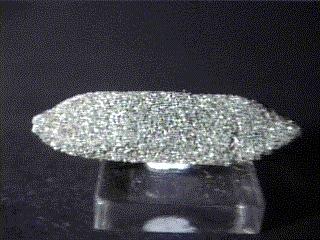
SPHENE specimen spe-1
$ 50.00
$ 50.00
Dims: 1-1/4" x 7/16" x 1/8"
Wt: 2.6 g
Teufelomuhle, Habachtal, Austria
At a cursory glance, this specimen appears to be a long, flat blade of Sphene with an interesting, rough surface. Closer examination will reveal that there is evidence of it being an end-to-end penetration twin- one can see a very light outline of one end of a crystal near the center of the specimen. Examination under magnification will show that the surface, and possibly the interior, are sprinkled liberally with tiny chlorite crystals! I like sphene anyway, but this is choice!
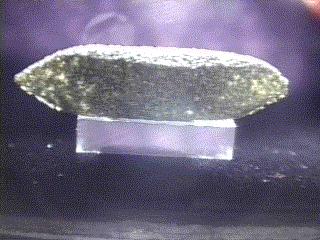

spe-1 ($ 50.00)
Teufelomuhle, Habachtal, Austria

SPHENE specimen spe-4
$ 21.00
$ 21.00
Dims: 0.8" x 0.5" x 0.3"(2.0 x 1.3 x 0.8 cm)
Wt: 1.1 g
Thormale, Nala, Pakistan
This excellent little thumbnail specimen consists of three intergrown, diamond-shaped, crystals of Sphene. The largest crystal is bladed in habit and has dimensions of 0.8 x 0.5 x 0.1" (2.0 x 1.3 x 0.3 cm), whereas all of the other two are much smaller and tend to be more prismatic in shape, and are each attached to a different edge of the larger one. All have a moderate to dark olive-green color and a waxy to vitreous luster depending on the faces viewed- the large crystals largest faces are quite dull, whereas the edge faces are much shinier. There seem to be tiny crystals covering the Sphenes that give them a dull sparkle. They may be microscopic Sphene crystals, or they may be tiny chlorite crystals, which are known to coat Sphenes. These crystals also coat a small, misshapen white calcite crystal that is attached to one of the larger faces on the large Sphene. It appears to have a gray coloration and a dull luster. I have affixed the specimen inside a domed plastic thimble box for display purposes.

spe-4 ($ 21.00)
Thormale, Nala, Pakistan
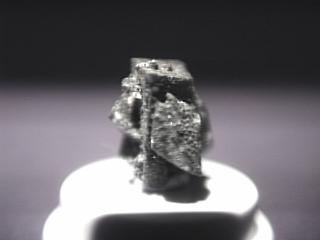
SPHENE specimen spe-5
$ 28.00
$ 28.00
Dims: 0.6" x 0.6" x 0.5"(1.5 x 1.5 x 1.3 cm)
Wt: 2.8 g
Thormale, Nala, Pakistan
Though this thumbnail specimen is quite small, it amazes me because I have counted 12 different prismatic Sphene crystals that are intergrown to make it up! They range in size from a few millimeters in all dimensions to 0.5 x 0.5 x 0.3" (1.3 x 0.8 x 0.8 cm). All have excellent crystal form, and there seems to be no visible damage. They are a very dark green in color, but I believe that this has mostly to do with a very heavy coating of tiny crystals that may be either chlorites or more sphenes. The specimen is affixed inside a domed thimble box for display.
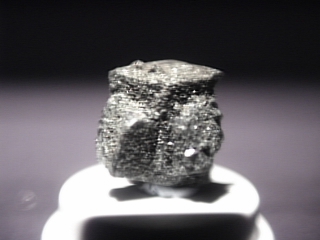

spe-5 ($ 28.00)
Thormale, Nala, Pakistan
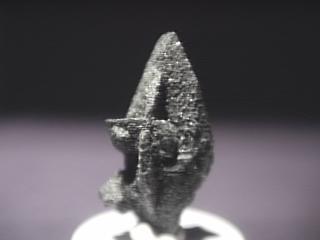
SPHENE specimen spe-6
$ 36.00
$ 36.00
Dims: 1.2" x 0.5" x 0.4"(3.0 x 1.3 x 1.0 cm)
Wt: 3.6 g
Thormale, Nala, Pakistan
I count at least 11 crystals of Sphene that are intergrown on this specimen. They occur in two forms: an oblong rhombohedral prismatic form, and a flat, diamond-shaped bladed form. The largest crystal is bladed and measures 1.2 x 0.5 x 0.1" (3.0 x 1.3 x 0.3 cm). Almost all of the other crystals are intergrown with it. Their forms are excellent, and there does not appear to be any visible damage to the cluster. It has a green color that is barely visible due to the fact that the cluster is coated with countless tiny crystals of either more Sphene or chlorite, which also almost destroy its translucence, which is only dimly visible along the edges of the large crystal in a bright light. It has an adamantine luster that is heavily interrupted by the tiny crystals. I have placed the specimen in a domed thimble box for display purposes. It is a very pretty little specimen.

spe-6 ($ 36.00)
Thormale, Nala, Pakistan
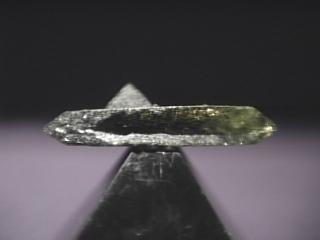
SPHENE specimen spe-7
$ 36.00
$ 36.00
Dims: 1.4" x 0.4" x 0.3" (3.6 x 1.0 x 0.8 cm)
Wt: 2.4 g
Thormale, Nala, Pakistan
This rather simple specimen consists of 3 intergrown Sphene crystals. The 2 larger crystals have a flat, elliptical, bladed form and show evidence of twinning, while the smaller crystal has an oblong, rhombohedral prismatic form. The largest crystal measures 1.4 x 0.3 x 0.2" (3.6 x 0.8 x 0.5). The cluster is partially covered with tiny crystals that I think are made of either more Sphene or possibly chlorite; these crystals provide heavy interference, making it difficult to see any transparence or even translucence, and in turn, the crystals' coloration, and spoiling their adamantine luster. However, one end of the larger crystal has a much lower concentration of these tiny crystals, so one can easily see the olive-green color and bright luster. The crystal's transparence is also visible, as are the many inclusions and internal fractures that spoil its clarity. I like it because it shows well what such a coating of small crystals can do to alter many aspects of its appearance.

spe-7 ($ 36.00)
Thormale, Nala, Pakistan
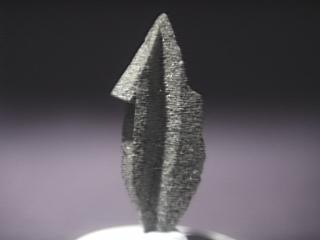
SPHENE specimen spe-8
$ 55.00
$ 55.00
Dims: 1.9" x 0.7" x 0.4" (4.8 x 1.8 x 1.0 cm)
Wt: 8.4 g
Thormale, Nala, Pakistan
This large thumbnail specimen consists of a cluster of at least 5 Sphene crystals. They range in length from a few millimeters to 1.9" (4.8 cm); the smaller crystals have a prismatic form resembling oblong rhombohedrons, whereas the larger crystals tend to have an elliptical bladed form. There is a very small amount of visible damage to one of the smaller crystals, but the cluster is in otherwise excellent condition. It is completely covered with a rather high concentration of what I think are either more, tiny Sphene or chlorite crystals. These crystals heavily interfere with several of the Sphenes' physical properties; their normally adamantine luster is somewhat dimmed, their normal translucent-to-transparent state is dimmed to near opacity, and their olive-green color is darkened to a near gray-black. However, glimpses of olive-green translucence are visible along the larger crystals' edges when the cluster is held up to a bright light. It is affixed inside a domed thimble box for display.

spe-8 ($ 55.00)
Thormale, Nala, Pakistan
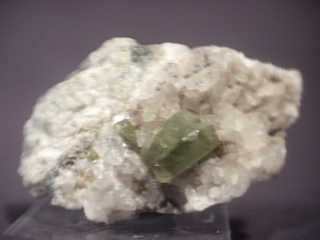
SPHENE specimen spe-9
$ 40.00
$ 40.00
Dims: 2.2" x 1.4" x 0.6" (5.6 x 3.6 x 1.5 cm)
Wt: 23.6 g
Thormale, Nala, Pakistan
This specimen of Sphene is different from most of the others in our selection for two reasons. First, it is one of the few pieces we have that consists of three crystals which are embedded into a piece of host rock, which seems to be made of layers of massive quartz, feldspar, and a gneiss of some sort. Secondly, the crystals are not covered with tiny crystals of either more Sphene or chlorite, as most in our selection are. The largest crystal measures 0.5 x 0.3 x 0.2" (1.3 x 0.8 x 0.5 cm), the smallest measures 2 mm at most in each dimension, and the third crystal is about halfway between the two. All are in excellent condition, with sharp edges and very clean faces. Near the center of one dimension on both the largest and the smallest crystal, there is a naturally occurring notch that is an obvious sign of twinning. They have an olive-green color that is a bit richer than most peridots that I have seen, and their luster is adamantine. All are somehwhat transparent, though their clarity is interrupted by many inclusions and internal fractures; the smaller crystals tend to be clearer, though. They rest amidst a cluster of small, white calcite crystals that partially coat the host rock.
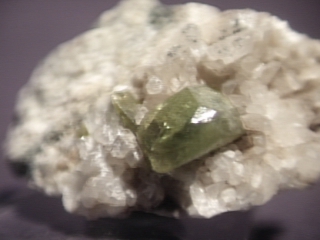

spe-9 ($ 40.00)
Thormale, Nala, Pakistan
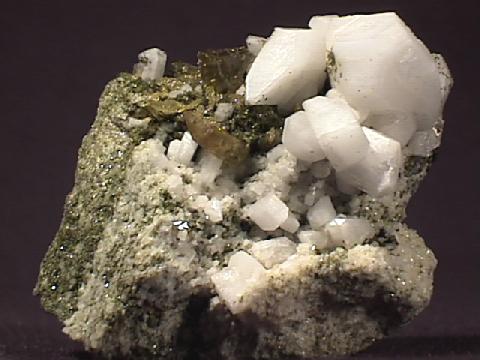
SPHENE specimen spe-11
$ 105.00
$ 105.00
Dims: 1.9" x 1.9" x 1.23" (4.8 x 4.8 x 3.0 cm)
Wt: 2.46 oz. (69.7 g)
Capelinha, Minas Gerais, Brazil
This specimen offers a "two-for-one" deal. Not only are there some superb Sphene crystals of near-gem-quality, but they are accompanied by several albite crystals with exceptional form. Though an entire face of the grainy host rock is covered with broken and incomplete crystals, the Sphenes that are intact show excellent form and no damage. They have a moderate yellow-green coloration and a bright, adamantine luster. All are transparent and somewhat clear, though their exteriors are heavily striated and their interiors show considerable internal fracturing. The two largest crystals have dimensions of about 0.4 x 0.3 x 0.1" (1.0 x 0.8 x 0.3 cm) and are the most noticeable. However, close examination will reveal that at their bases are clustered many tiny, prismatic crystals that have a slightly warped, diamond-shaped cross-section and a darker, almost forest-green coloration. These do not exceed 2 mm in length, and at least 10-power magnification is needed to effectively examine them. The albites are in close association with the Sphenes and are amazinly undamaged. They range in size from a few millimeters in any dimension up to 0.6 x 0.5 x 0.4" (1.5 x 1.3 x 1.0 cm), and show exceptional triclinic prismatic form. Their color is milky white and their luster is dull and waxy. The matrix upon which all of this rests seems to be made of tiny crystals of each mineral that were intermixed and compacted.
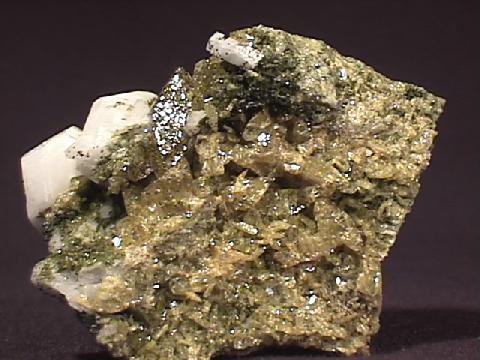

spe-11 ($105.00)
Capelinha, Minas Gerais, Brazil
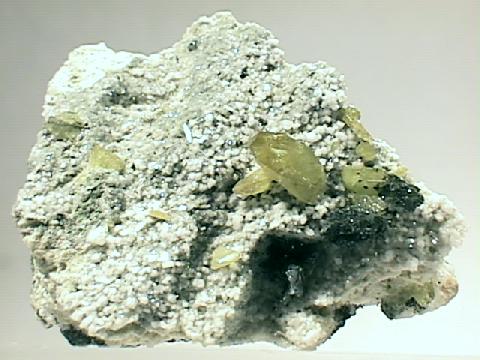
SPHENE specimen spe-12
$ 40.00
$ 40.00
Dims: 2.4 x 2.0 x 1.2" (6.1 x 5.1 x 3.0 cm)
Wt: 2.28 oz. (64.6 g)
Gilgit, Pakistan
At least 10 discernable Sphene crystals rest on the gray-white host rock of this thumbnail specimen. Though a few of them are broken, those that are intact are in excellent condition and reach dimensions of 0.4 x 0.2 x 0.2" (1.0 x 0.5 x 0.5 cm). They generally have excellent monoclinic prismatic form, and most show evidence of twinning. Their edges are well-defined and their faces are generally clean, though a few are coated with what may be tiny chlorite crystals. All have the pale yellow-green color and adamantine luster that are standard for this species, and are dimly transparent due to considerable internal fracturing. They rest on a base rock that I believe is made up mostly of albite.

spe-12 ($ 40.00)
Gilgit, Pakistan
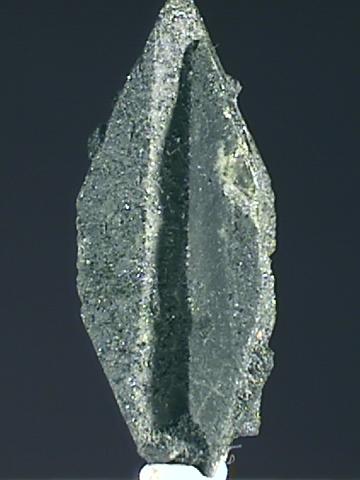
SPHENE specimen spe-13
$ 50.00
$ 50.00
Dims: 1.2 x 0.4 x 0.4" (3.0 x 10.1 x 0.9 cm)
Wt: 4.0 g
Gilgit, Northern Areas, Pakistan
At least 8 flat, bladed Sphene crystals make up this large thumbnail specimen. The largest crystal is twinned in the classic form for this locality, and resembles a deflated American football. It is noticeably damaged at one end, but the smaller crystals are in excellent condition. All have the standard monoclinic form, and I believe that at least one other crystal is twinned- these smaller crytals are partly intergrown with the larger one. All have an olive-green color that is darkened to near opacity by chlorite inclusions, and their normally adamantine luster is dulled to greasy or pearly, also probably due to the chlorite. There is no host rock present.
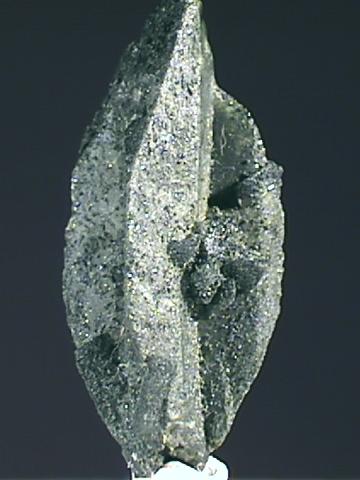

spe-13 ($ 50.00)
Gilgit, Northern Areas, Pakistan
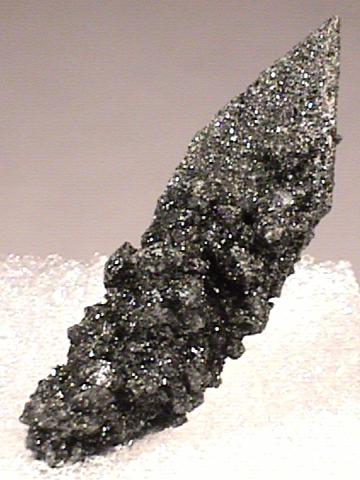
SPHENE specimen spe-14
$ 30.00
$ 30.00
Dims: 1.6 x 0.5 x 0.4" (4.1 x 1.4 x 1.1 cm)
Wt: 8.3 g w/ specimen box
Gilgit, Northern Areas, Pakistan
This specimen consists of a single large, flat Sphene crystal that acts as a base to several much smaller crystals. The large crystal has dimensions of 1.3 x 0.4 x 0.1" (3.4 x 1.1 x 0.4 cm), and like most of the smaller ones, is in excellent condition, showing no damage. Its monoclinic, bladed form is very good, though that of the smaller crystals is mostly spoiled due to intergrowth. The large crystal has a yellow-green coloration that is essentially destroyed by concentrated chlorite inclusions, as is any vestige of transparence or translucence- all are essentially opaque. There is no host rock present, and the piece is hot-glued into a plastic specimen box.

spe-14 ($ 30.00)
Gilgit, Northern Areas, Pakistan
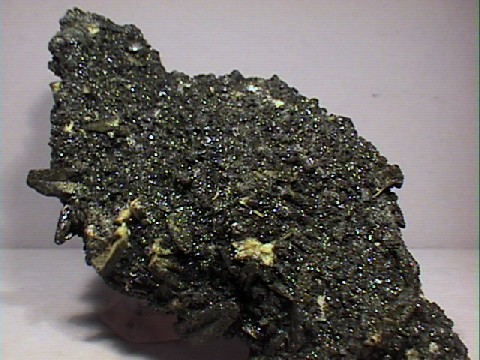
SPHENE specimen spe-15
$ 65.00
$ 65.00
Dims:6.9x3.2x1.8" (17.5x8.1x4.6 cm)
Wt: 17.0oz. (483g)
Gilgit, Pakistan
Dozens of sphene crystals protrude from the matrix of this specimen.The matrix material is unknown to me-I have never seen anything like it. The longest sphene crystal is 1.0" (2.5cm) in length, and is double terminated. Several of the crystals are broken or damaged, but the ones that are intact are excellent. It is unusual to find so large a cabinet specimen of this mineral.
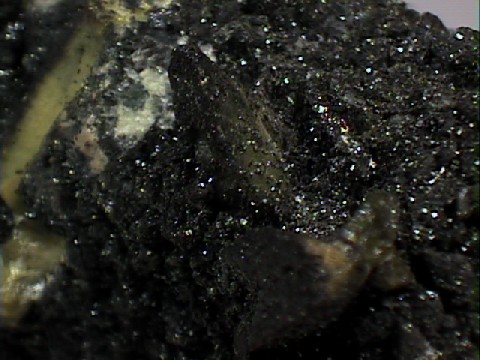

spe-15 ($ 65.00)
Gilgit, Pakistan

SPHENE specimen spe-16
$ 54.00
$ 54.00
dims mm=99.14x59.16x14.92
wt g=120
Khibiny, Kola Peninsula, Russia
This is a most unusual sphene specimen. First of all, the crystals are yellow, not green. Second, they are organized as tightly packed radial clusters of blades. The crystals are transparent and vitreous. The specimen consists almost entirely of sphene crystals and opaque black aegirine crystals; one side has been polished flat.


spe-16 ($ 54.00)
Khibiny, Kola Peninsula, Russia